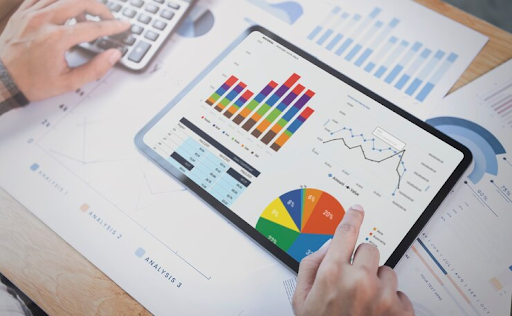Analytics and reporting have transformed the way businesses operate. From the early days of simple data collection to today’s sophisticated business analytics tools, understanding metrics through analytics reports, time analytics, and an interactive analytics dashboard is crucial. Companies now rely on analytics, including market data reports and report data, to make informed business decisions and drive growth. Reporting not only highlights performance through data analytics but also uncovers trends and insights for business. This evolution empowers organizations to adapt swiftly in a competitive landscape using data analytics and a reporting analytics tool. In this post, we’ll explore key aspects of analytics and reporting that can elevate your business strategy. Get ready to dive into actionable insights from the report that can reshape your approach to data-driven decision-making.
Understanding Reporting and Analytics
Reporting Defined
Reporting involves the presentation of structured data. It provides insights into specific metrics over time. Businesses use reporting analytics to track performance. This includes operational reporting, which focuses on daily operations. Regular reports help organizations identify trends and monitor key performance indicators (KPIs).
The Role of Analytics
Analytics is about deriving meaningful insights from data. It goes beyond simple summarization. Descriptive analytics summarizes historical data for understanding past performance. Advanced reporting tools can visualize this data effectively. Data analysts utilize these tools to explore patterns and correlations in the report.
Importance in Decision-Making
Both reporting and analytics play crucial roles in decision-making. Organizations rely on accurate data reporting to inform strategic planning. Valuable insights gained through analytics guide future actions. They help businesses adapt to changing environments, report, and improve operations.
Data collection methods also influence the quality of insights. Effective data exploration leads to better understanding and identification of opportunities in the report. Companies that leverage these techniques gain a competitive edge.
Key Differences Between Reporting and Analytics
Historical Data
Reporting serves as a snapshot of historical data. It collects information from various sources and presents it in a structured report format. This allows businesses to see past performance. Reports typically include metrics like sales figures or website traffic for specific periods. They help stakeholders understand what has already occurred.
Dynamic Exploration
Analytics, however, goes beyond mere reporting. It is dynamic and focuses on uncovering trends. Analysts explore data deeply to find patterns and correlations. This exploration informs future predictions, guiding strategic decisions. For example, analytics can reveal customer behavior trends over time, which reporting alone cannot provide.
Purpose of Each
The purpose of reporting is straightforward. It answers the question: “What happened?” In contrast, analytics seeks to answer “Why did it happen?” and “What actions should we take next?” This distinction is crucial for organizations aiming to improve their decision-making processes and report on outcomes.
Understanding these differences helps businesses leverage both tools effectively. Reporting provides the necessary context, while analytics drives insights that lead to actionable strategies. Together, they create a comprehensive report of performance and future opportunities.
Benefits of Reporting and Analytics
Transparency
Reporting fosters transparency within an organization. It allows stakeholders to see the data clearly. Regular reports build trust among team members and executives. They hold individuals accountable for their performance. When everyone understands the metrics in the report, it encourages responsibility and ownership.
Customer Experience
Analytics enhances customer experiences significantly. It provides personalized insights that cater to individual preferences. Companies can analyze purchasing patterns to tailor marketing strategies. This targeted approach leads to higher customer satisfaction. Customers feel valued when they receive relevant offers based on their behavior, report.
Operational Optimization
Both reporting and analytics play key roles in optimizing business operations. They help identify inefficiencies and areas for improvement. By analyzing data trends, organizations can make informed decisions. This strategic planning supports long-term goals, competitive advantage, and report. Businesses that utilize these tools can adapt quickly to market changes.
Strategic Planning
Effective reporting aids in strategic planning processes. It highlights important data points that influence decisions. Organizations can set realistic goals based on historical data. Analytics further refines these strategies by predicting future trends. This combination empowers businesses to stay ahead of competitors.
The Reporting Process Explained
Data Sourcing
Proper reporting begins with sourcing data from operational systems. This involves identifying relevant data sets that align with reporting needs. Teams gather data from various sources, such as databases and applications. They ensure the data is accurate and complete for effective reporting.
Data Transformation
Once sourced, raw data undergoes transformation. This process converts unstructured data into a comprehensive repository. Structured formats allow for easier analysis. Analysts clean and organize the data, making it ready for management reports. This step fosters transparency in the reporting process.
Automation Importance
Automating reports enhances efficiency. Timely delivery to stakeholders becomes crucial for decision-making. Automated reporting features provide regular updates without manual effort. This ensures accountability and keeps everyone informed of key metrics.
Dynamic reporting options further improve accessibility. Stakeholders can view real-time data, allowing for quick adjustments based on report results. Regular reporting also supports strategic planning by providing consistent insights.
In summary, effective reporting relies on accurate data sourcing, proper transformation, and automation to meet organizational goals.
Types of Reports and Examples
Report Types
Organizations utilize various report types to meet their specific needs. Operational reports track daily activities. Financial reports monitor budget and expenses. Compliance reports ensure adherence to regulations.
Structured Reports
Structured reports present data in a consistent format. These include monthly performance summaries. They highlight key metrics, making it easy for stakeholders to assess progress.
Basic Reports
Basic reports focus on straightforward data presentation. They often summarize findings without extensive analysis. For example, a weekly sales report shows total sales figures without detailed insights.
Trend Reports
Trend reports analyze patterns over time. They help organizations identify growth areas or potential issues. For instance, a trend report may reveal declining customer satisfaction over several months.
Ad Hoc Reports
Ad hoc reports address specific questions as they arise. They provide immediate insights for decision-making. For example, an HR manager might request an ad hoc report to understand employee turnover rates quickly.
Visual Aids
Visual aids enhance the understanding of complex data. Charts and graphs make trends more visible. These tools improve communication among team members and stakeholders.
The Analytics Process Explained
Data Movement
Data moves into a repository for analysis through a structured data analytics process. Analysts use analytics tools to extract, transform, and load (ETL) data from various sources. This ensures the information is clean and ready for further exploration. Once in the repository, it can be accessed for deeper analysis.
Identifying Patterns
Identifying patterns is crucial in the analytics phase. Analysts look for trends that reveal insights about operational systems. For example, they might analyze sales data to uncover seasonal buying behaviors. These insights help businesses make informed decisions and improve operations.
Iterative Nature
The analytics process is iterative. Insights gained from one analysis often lead to new questions. Analysts may delve deeper into specific factors affecting performance. This depth analysis allows organizations to refine their strategies continuously. Predictive techniques can also be employed to forecast future trends based on historical data.
Techniques Used
Various statistical techniques are applied throughout the analytics process. Exploratory analysis helps analysts understand the data’s structure and relationships. Advanced analysis methods provide more profound insights, enhancing decision-making capabilities.
Examples of Analytical Reports
Diagnostic Reports
Diagnostic reports assess past performance. They analyze data to identify trends and issues. For example, an accounting report may reveal discrepancies in financial statements. Businesses can use this information to understand what went wrong and take corrective actions.
Predictive Reports
Predictive reports forecast future outcomes based on historical data. These analytical reports utilize statistical models and machine learning techniques. In marketing, predictive analytics can estimate customer behavior over a specific time period. This helps companies tailor their strategies effectively.
Prescriptive Reports
Prescriptive reports recommend actions based on analysis. They guide decision-makers by suggesting optimal paths forward. Operational reports often include these recommendations to improve efficiency. For instance, a logistics company might receive insights on the best routes to reduce costs and delivery times.
Strategic Decisions
Analytical reports inform strategic decisions across industries. They help businesses align their goals with market realities. For example, finance departments rely on operational reports to manage budgets effectively. Marketing teams use predictive analytics to allocate resources wisely.
Practical Applications
Industries apply analytical reports in various ways. In healthcare, diagnostic reports track patient outcomes for quality improvement. Retailers use predictive analytics for inventory management, ensuring products meet customer demand.
Reporting and Analytics Comparison
Core Functions
Reporting and analytics serve distinct yet complementary roles in data management. Reporting focuses on presenting static data through dashboards. It provides a snapshot of performance metrics, such as sales figures or website traffic. Organizations use these reports to track key performance indicators (KPIs) over time.
Analytics goes further by interpreting data. It uncovers trends and patterns that help organizations make informed decisions. For instance, an analytics tool can analyze user behavior, revealing insights about customer preferences. This depth of understanding is crucial for strategic planning.
Outputs Contrast
The outputs differ significantly between reporting and analytics. Reports often consist of static presentations, such as charts and graphs. They summarize historical data without offering much context. In contrast, analytics generates actionable insights. These insights can prompt immediate changes in marketing strategies or operational efficiency.
Integration Benefits
Organizations benefit from integrating both reporting and analytics. Combining these elements creates a holistic view of performance and strategy. Automated reporting tools streamline the process, saving time for teams. Interactive analytics dashboards allow users to explore specific metrics in real-time.
Utilizing detailed trend reports alongside market data reports enhances decision-making processes. Companies can adjust their strategies based on reported metrics and performance trends. This integration ultimately leads to improved efficiency and better outcomes.
Closing Thoughts
Reporting and analytics are your secret weapons for making sense of data. They’re not just buzzwords; they’re essential tools that help you navigate the complex world of information. Understanding their differences and benefits can empower you to make smarter decisions. You’ve seen how each process works and the types of reports available. It’s all about finding what fits your needs best.
Now it’s time to take action. Dive into your data, embrace reporting, and harness analytics to drive your strategies forward. The insights you uncover can lead to game-changing results for you and your team. So, roll up your sleeves and start exploring—your next big breakthrough is just a report away!
At BeeSavvy, we help businesses like yours make sense of their data. Whether you’re looking to streamline reporting or dive deep into analytics, we’ve got the tools and expertise to guide you. Ready to take your data strategy to the next level? Contact Us today and let’s make data work for you!



